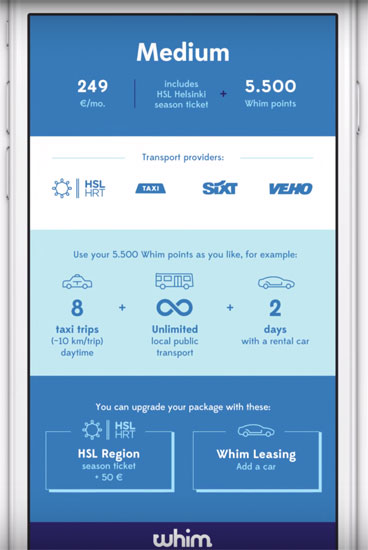This October, the Finnish company MaaS Global launched Whim, an app that serves as a portal to a wide array of transportation services. Helsinki residents who sign up for Whim pay a flat fee for unlimited access to transit and get points that can be spent on taxi rides or car rentals.
It's all part of the Finnish Ministry of Transport and Communications' effort to adopt a "mobility as service" model. The concept goes a lot deeper than a trip planner or fare payment mechanism on your smartphone. At its core, "mobility as service" is about minimizing car ownership.
Instead of people paying large sums and taking on debt to own a depreciating asset, which they can then drive around cheaply, "mobility as service" connects people to the best option for any given trip. The key is to make this service as seamless, convenient, and economical as possible.
At a TransitCenter panel last night, Finnish officials discussed how they re-wrote the nation's transportation regulations to optimize the mobility-as-service model.
Before Whim could launch, said the transport and communications ministry's Krista Huhtala-Jenks and MaaS Global CEO Sampo Hietanan, Finland had to streamline rules that got in the way. Regulations that, for example, treated traditional taxis differently than companies like Uber and Lyft were an obstacle.
This process of "de- and re-regulation," as Huhtala-Jenks called it, aims to make the mobility-as-service market as attractive as possible for both the transportation providers and the people buying these services. It's not about creating rules on a case-by-case basis.
"We're not in the business of putting out fires," she said. "So we're not taking separate cases like almost [everyone else] in the world that, 'Oh, we have this case of Uber, let's regulate it.' We don't want to start spot-regulating. That world is gone already."
The new regulatory landscape isn't the Wild West. The Finnish government still steps in to solve problems as they emerge. But the ultimate goal of any intervention is to guarantee that no matter the time or location, Finns have access to transportation.
"Even if we're deregulating, us [at] the public sector, we will have the tools, the data, to follow on a system level and react if there's, for example, market failures, or if we're not moving towards our policy goals," said Huhtala-Jenks. "Our regulation, it can't be future-proof, but it can be future-ready. We shouldn't even try to keep up with the technology at the different services, but we should create the right environment for it -- where it can flourish but we can also react when it's needed."
One new requirement is that mobility providers must make their trip data available to the public and the government, something that Uber, Lyft, and other companies have been very reluctant to do in the United States. This data then informs other rules.
Of course, Finland is a country of 5.5 million people -- less than the weekday ridership of the New York City subway. A complete overhaul of national transportation regulations is not only easier to enact, but also easier to adjust down the line.
MBTA Chief Technology Officer David Block-Schachter, also on the panel, said that American transit agencies need to put new fare collection technology in place to be prepared for the "right moment" when mobility-as-service becomes politically viable. American systems' current reliance on cash payments would make implementation expensive.
To wrangle detailed trip data from mobility providers, Block-Schachter said American officials could offer to subsidize some of their business, like late-night trips. The companies get more business and the government gets the information it needs to set up smart regulations.
Public agencies need to figure out these points of leverage and how to make them work for residents if they're going to set up successful mobility-as-service systems. "There will always be public money in the transport sector, one way or another," said Huhtala-Jenks. "We need to use that as leverage, but we need to get smarter about it."





